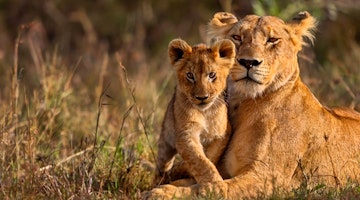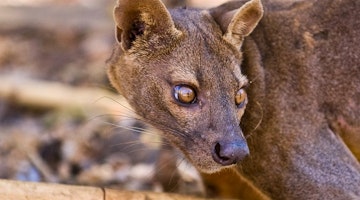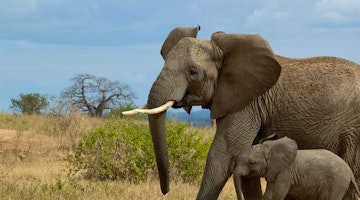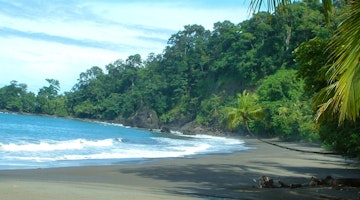Ranomafana National Park is a particularly rich and beautiful mid-altitude montane rainforest reserve in south eastern Madagascar. The park was created in 1991 to protect the critically endangered Golden Bamboo lemur, discovered by Dr. Patricia Wright in 1986, and the critically endangered Greater Bamboo lemur, rediscovered around the same time.
Ranomafana's habitat
The core protected zone contains 41,600 hectares of mid-altitude montane forest. Superficially, Ranomafana bears a strong resemblance to the rainforests of Analamazaotra and Mantadia, with which this park shares many species.
Ranomafana is mountainous, with some long slopes and elevations ranging from 600 – 1400m. The range of altitudes allows for different forest types, from lowland rainforest to cloud forest and high plateau forest. The rare mountain top flora and fauna around Mount Maharira, in the south of the park, is shared only with Andringitra, 130 km further south.??Numerous small streams feed the Namorona River, which bisects the park. Large rivers are also found in the northern and southern parts of Ranomafana.A variety of orchids are a particular feature of Ranomafana. A reasonable level of fitness is a requirement for visiting this national park. Most of the trails traverse long slopes, some of which have steep sections.
Mammals
Ranomafana is one of Madagascar's richest rainforest wildlife sites. It contains a dozen lemur species and you are likely to see Red-fronted brown lemurs, Lesser eastern grey bamboo lemur, Milne-Edwards’ sifaka and the Red-bellied lemur. The park is best known for holding all three species of Bamboo lemur, and increasingly, visitors are successful in seeing the extremely rare and localised Golden and Greater bamboo lemurs.??Night walks on the periphery of the park are most productive in summer and autumn months (September to May). Aside from Eastern woolly lemur, Small-toothed sportive lemur, Greater dwarf lemur and Rufous mouse lemur, the guides can usually coax out some well-habituated Malagasy striped civet (fanaloka).??
Visitors who want to seek radio-collared Aye ayes can make the challenging night hike at Kianjavato, near Ranomafana. A high level of fitness is required to complete this excursion and it must be arranged in advance - ask us for details.
Other mammals include seven species of the insectivorous tenrec and two species of mongoose.??The varied herpetofauna includes Parson's chameleon, Short-horned chameleon, and three of the famous Leaf-tailed (Uroplatus) gecko. It is a good site for the largest, the Fringed gecko, and the bizarre Satanic leaf-tailed gecko.
As is the case in Andasibe, most reptiles and frogs are best seen during night walks, when chameleons in particular initially reflect white in the beam of a torch. The numerous frogs include the colourful Painted or Madagascar mantella and many of the Boophis tree frogs. ?Ranomafana is excellent for the massive Madagascar lunar (comet) moth.
Birds
Ranomafana holds 118 bird species and birders can expect to see most of the island's rainforest-dependent endemics. The wary Brown mesite, Velvet asity, Rufous-headed ground-roller, Forest rock-thrush, Grey-crowned greenbul and Blue, Hook-billed and Chabert's vangas are best sought here.
When to visit
Ranomafana is a rainforest reserve: annual rainfall varies from 2300 – 4000 mm and falls up to 320 days per annum. Wildlife viewing is most productive from mid-September to May. In winter (June to August) nights can be very cold. Monthly rainfall is highest from December to March and lowest from May to October. We do need to advise that there are no good hotels at Ranomafana - those that we utilise are the best available but are adequate/acceptable.
Location
The national park lies 90km west of the Indian Ocean on the east-facing escarpment of Madagascar's central high plateau, 60km east of Fianarantsoa, Madagascar's second city, and roughly 400km southeast of Antananarivo. With the completion of the road from the Vohiparara turnoff (RN25), the scenic overland journey from the capital can be accomplished in approximately 9 hours. The park entrance is 7 km from the town of Ranomafana, which developed around the thermal baths, the first source of Ranomafana’s fame. We highly recommend our clients visit Centre Valbio, which is under the direction of Dr Patricia Wright. facilitates hands-on science to sustain the people and country's resources. This is done with the participation of local communities.
Conservation
In 2003, Prof Wright and her team created Centre ValBio - a driving force behind a 27-year long conservation project - to enable resident communities and an international audience, to understand the value of biodiversity conservation in Madagascar and elsewhere. Aside from promoting cutting edge research in this area of exceptionally rich biodiversity, the centre aims to encourage development of ecologically sustainable development programmes with resident communities. Villagers are assisted with knowledge and tools with which to improve their quality of life though projects focused on sanitation, education and diet. Ultimately, the aim is poverty reduction. We can prearrange for guests to visit the impressive NamanaBe hall right near the park, where there is accommodation for researchers and impressive, well-equipped labs for biodiversity research. Also facilitated at the hall are on-site health and hygiene education programmes and visiting medical professionals are hosted there. It is a hub for national youth education programmes such as UNICEF's Connecting Classrooms.
Current Research and projects
Patricia Wright and her team from ICTE (Institute for the Conservation of Tropical Environments; Stony Book University) are conducting research on the Ecology of Infection, i.e. a pilot study of zoonotic exchange among people, wildilfe and livestock around Ranomafana National Park. It is known that pathogens are transmitted between humans, wildlife (lemurs and other small mammals) and livestock (cattle and pigs) and that these can be highly destructive. but currently little is known as to how and why, they are transmitted. The overall aims of this study is to determine how anthropogenic changes (habitat modification by people) to tropical forest ecosystems place humans, livestock and wildlife living in those ecosystems, at risk of interspecific infection. The results of these studies are being used in the implementation of public health measures for communities living around areas of biological significance.
Among many other fascinating research programmes under way at Ranomafana, is one on the conservation of the Greater bamboo lemur (Prolemur simus); a study on Carnivore occupancy and density in Ranomafana using camera trapping and Assessment of the impact of invasive specis on native biodiversity in the national park.
There is a 10ha Arboretum 2km from the village of Ranomafana, constructed on the initiative of the Protestant Development Organisation with American missionary Dan Turk, with assistance from FOFIFA's scientific researchers. Ereance fees go to the resident community.
Derek Schuurman
Travel Specialist
Looking for inspiration?
You'll find expert travel guides, holiday ideas and insider tips now on the Rainbow blog

Top 5 First Time Safari Destinations

10 Strange Animals and Where to Go to See them


Salar De Uyuni - The World's Largest Salt Flat


Top five South Africa Safari lodges

Sustainable Tourism In Corcovado National Park, Costa Rica

Why Choose Us?
Passionate travel experts
- We've been leading wildlife travel since our first South Africa tours over 25 years ago
- Our Travel Specialists have lived in their specialist area for years
- We work with local guides to immerse you deeper in our diverse range of experiences
Personal & tailor-made
- You'll speak to your own expert who'll share their first-hand knowledge
- We'll make your itinerary seamless with 24/7 emergency contact available
- Your Travel Specialist will listen to ensure you have the best chance of seeing the wildlife you love
Responsible by nature
- We take care to actively contribute to the conservation of environments we visit
- For select countries, we make a charitable donation on your behalf when you make your booking
- We've partnered with conservation experts and NGOs to curate responsible tours
For the latest travel advice from the Foreign, Commonwealth and Development Office check www.gov.uk/travelaware



